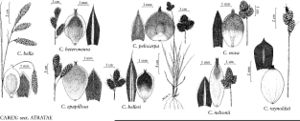Carex raynoldsii
Amer. J. Sci. Arts, ser. 2, 32: 39. 1861.
Plants cespitose. Culms 20–75 cm, smooth. Leaves 3–7 mm wide. Inflorescences: proximal bracts shorter than or exceeding inflorescences; spikes separate, short-oblong or elongate, 10–20 × 3–5 mm, of similar length; proximal spikes often divergent to pendent, long-pendunculate; distal spikes divergent or erect, short-pendunculate; lateral 2–4 spikes pistillate; terminal spike staminate. Pistillate scales brown or black, margins hyaline, lanceolate, shorter than or equaling and narrower than perigynia, midvein same color as body, inconspicuous or lighter colored and conspicuous, often raised, prominent, apex acute or short-mucronate. Perigynia ascending, spreading, greenish yellow or yellow-brown, veined, broadly elliptic or obovate, 3.5–4.5 × 1.75–2 mm, apex abruptly beaked, smooth; beak 0.3–0.5 mm, bidentate, smooth. Achenes nearly filling body of perigynia. 2n = 58.
Phenology: Fruiting Jun–Aug.
Habitat: Subalpine and alpine meadows
Elevation: 1000–3200 m
Distribution

Alta., B.C., Sask., Calif., Colo., Idaho, Mont., Nev., Oreg., Utah, Wash., Wyo.
Discussion
Selected References
None.
